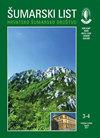State border fences as a threat to habitat connectivity
IF 0.4
4区 农林科学
Q4 FORESTRY
引用次数: 2
Abstract
The conservation value of transboundary management of wildlife populations in Europe, that marked end of the 20th and the beginning of the 21th century, has come under huge pressure since 2015 especially in the South-eastern Europe due to border fences construction in response to large influxes of refugees/migrants. The primary aim of this study was to present data on the direct impacts of the long fence on wildlife (e.g. fence-related mortality) across the Hungary–Croatia border. We collected data on fence-related animal mortality along 136 km of the fence in the first 28 months after its construction. In total, 64 ungulates (38 red deer, 23 roe deer, and three wild boar) were found entangled in or deceased due to the razor wire fence. In addition, we present direct (photographic) evidence of newly recorded behaviour of red deer, as they gather in huge herds attempting to cross the border fence between Hungary and Croatia. Short term effect of the border fence is reflected in direct animal mortality, and as obstruction to the movement and behaviour of animals. In the case that current fences will remain or continue to expand along the northern boundary of South-eastern Europe, it is likely that fragmented wildlife populations in the region will suffer from negative effects of genetic subdivision such as loss of alleles and reduced heterozygosity that can cause important long-term damage to their vitality.州边界围栏威胁到栖息地的连通性
20世纪末和21世纪初,欧洲野生动物种群跨界管理的保护价值自2015年以来面临巨大压力,特别是在东南欧,原因是为应对难民/移民的大量涌入而修建边境围栏。这项研究的主要目的是提供关于长围栏对跨越匈牙利-克罗地亚边境的野生动物直接影响的数据(例如围栏相关的死亡率)。我们收集了在围栏建成后的前28个月内,136公里围栏沿线与围栏有关的动物死亡率数据。总共发现64只有蹄类动物(38只马鹿、23只狍子和3只野猪)被铁丝网缠住或死亡。此外,我们提供了马鹿新近记录的行为的直接(摄影)证据,因为它们聚集在一起,试图越过匈牙利和克罗地亚之间的边界围栏。边界围栏的短期影响反映在动物的直接死亡率上,并阻碍动物的运动和行为。如果目前的围栏沿着东南欧的北部边界保持或继续扩大,那么该地区分散的野生动物种群很可能会遭受遗传细分的负面影响,例如等位基因的丧失和杂合性的降低,这可能会对它们的活力造成重大的长期损害。
本文章由计算机程序翻译,如有差异,请以英文原文为准。
求助全文
约1分钟内获得全文
求助全文
来源期刊

Sumarski List
FORESTRY-
CiteScore
0.90
自引率
20.00%
发文量
32
审稿时长
>12 weeks
期刊介绍:
Forestry Journal publishes scientific and specialist articles from the fields of forestry, forestry-related scientific branches, nature protection and wildlife management.
 求助内容:
求助内容: 应助结果提醒方式:
应助结果提醒方式:


